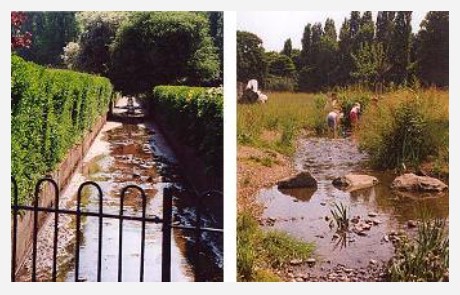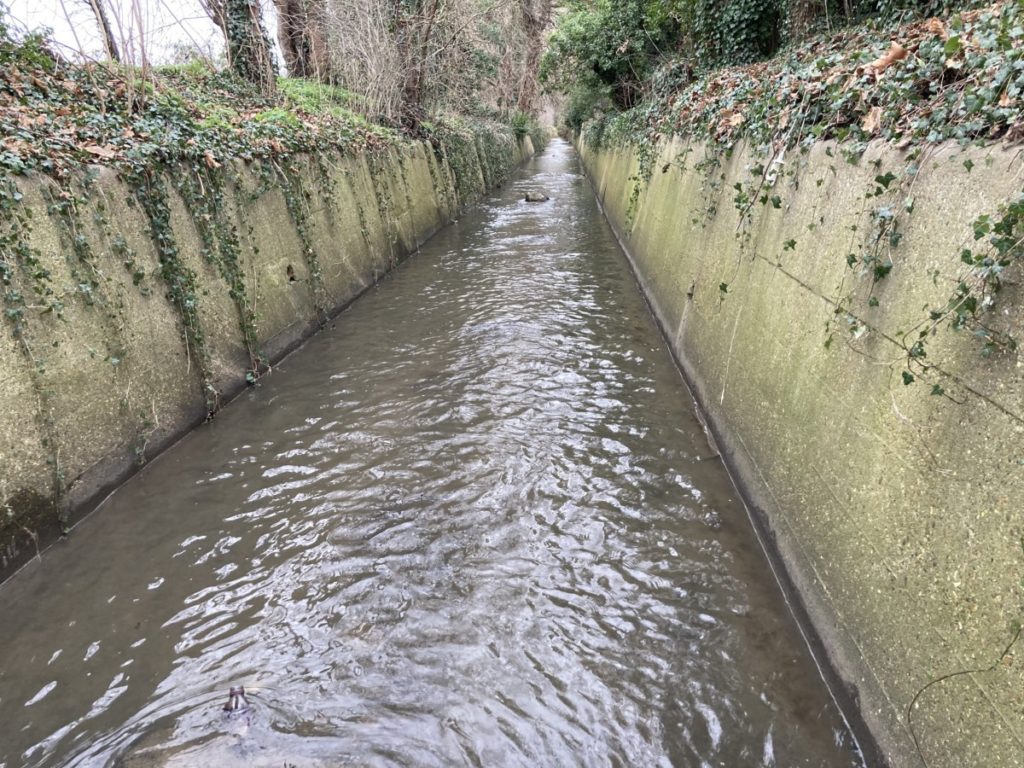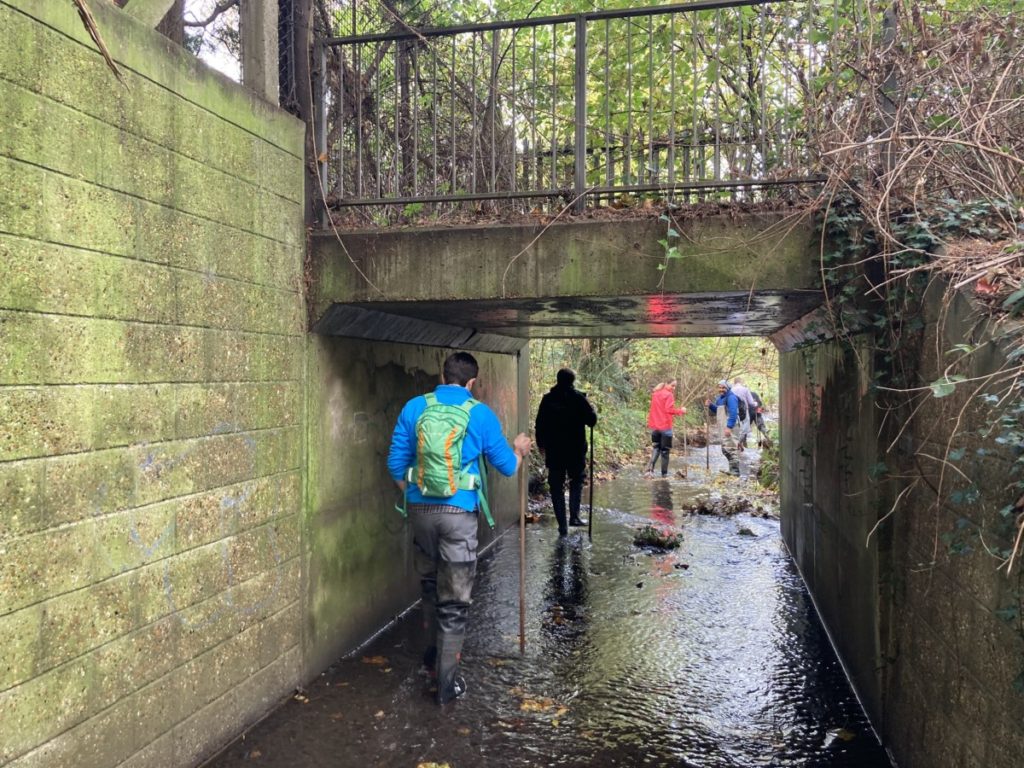Written by:
In December 2023, The Glass-House facilitated a workshop for the Scottish Wildlife Trust, as part of their Pioneers Programme training for their Nextdoor Nature project. We were hugely inspired by the many and varied projects being explored and activated by these community champions to activate underused green spaces in their areas. As part of the workshop we designed for them, we referenced a number of community-led green space projects around the country that had inspired us. We have since been asked by our friends at Scottish Wildlife Trust to share a bit more about one of these stories of community-led action and cross-sector collaboration. At their request, I am sharing one of my all time favourites, a both inspired and inspiring example I go back to again and again, the Quaggy Waterways Action Group (QWAG).
QWAG has now celebrated over three decades of community-led action, but the transformation of Chinbrook Meadows in Lewisham and Sutcliffe Park in Greenwich South London), which grew out of QWAG’s Operation Kingfisher proposal in 1995, has both stood the test of time and has demonstrated a marked impact on both flood alleviation and biodiversity in the area.

The catalyst for this was the problem of recurring flooding from the river that ran along the end of the back gardens of a terrace in Lewisham. The Quaggy River was culverted (in a concrete channel) for much of its journey through the area, and the bit behind the houses was in an open channel that persistently flooded the gardens in heavy rainfall. When the council suggested repairing and reinforcing the concrete channel, a small group of residents wondered whether that would in fact change anything and whether there might not be a better way to approach the problem.
This was the beginning of the Quaggy Waterways Action Group.

They did their research, contacting flood alleviation experts and seeking advice and ideas. From this research emerged a proposal to tackle the persistent flooding by releasing the river from its concrete channel at key points on its route, and allowing it to expand into park spaces which were better able to absorb and disperse the water. Their research revealed that not only could this play an important role in tackling local flooding, but that by allowing seasonal changes to the water levels in the park, this could also play a significant role in enhancing biodiversity and supporting plant and wildlife.
QWAG took their proposal to both their local authority, LB Lewisham, and to the Environment Agency and there began Operation Kingfisher, a long process of exploration and negotiation. This led to a proposal to release a relatively short 30 metre stretch of the river from its culvert. Ultimately, most of the river was freed to flow through Chinbrook Meadows, a former grazing meadow turned park, for the first time since 1935, when the river had been culverted.
The Impact of Changing Approach
The restored Chinbrook Meadow was a huge success, and led to further de-culverting projects along the river including Sutcliffe Park in Greenwich. The QWAG website sites a 2005 report “… into the contribution of the voluntary and community sector to economic and social outcomes in Lewisham noted:
- How restoring the river and park had brought significant economic benefits to the area – £1.1 million raised, with 52.5% from sources outside the borough.
- The social benefits that followed restoration – where a little used open space was transformed into a popular park, cherished and cared for by local people of all ages.
The report also highlighted QWAG’s contribution saying:
- QWAG’s actions and methods have brought wide benefits to the local community – the economic and social benefits of QWAG’s involvement with Chinbrook Meadows are particularly emphasised.
- Its initiation of a natural flood alleviation scheme that avoids concrete channelling, has increased biodiversity and made aesthetic improvements to the area.
- QWAG’s collaboration with the statutory sector is seen as a good example of ‘co-production theory’ – efficient results coming from local residents participating in producing public goods and services.
- The group’s local knowledge and enthusiasm has meant that “the river authority can work towards… integrated flood alleviation across boroughs.”

A Much Celebrated Group and Series of Projects
I first encountered the Quaggy Waterways Action Group back in 2007, when I was a member of the judging panel for the British Urban Regeneration Association (BURA). I was sent to do an assessment visit and was absolutely blown away by what they had achieved. I became an enthusiastic champion for the project, and was delighted when the group’s work to transform Chinbrook Meadow and Sutcliffe Park won the Waterways Renaissance Awards’ Natural Environment category. BURA was not alone in celebrating it. Chinbrook Meadows won Green Flag status in 2003-04. In 2004, it was cited as one of 23 world-wide exemplary projects in Urban River Basin Enhancement Methods, a study funded by the European Commission. In 2005, the Commission for Architecture and the Built Environment (CABE) featured Chinbrook Meadows and the restoration of Sutcliffe Park further downstream as a best practice case study. It was also cited as an exemplary project in both Lewisham’s 2005 Community Engagement Strategy, Valuing the Community and Voluntary Sector and a 2006 University of West England report for the Environment Agency.
Sharing Learning to Inspire Others
While this project has stayed firmly in my head since 2007 when I encountered it, and despite me continuing to tell people all round the country about it, it is striking to me that more people and places have not heard of and learnt from the QWAG story.
This, despite our experience with so many great community-led projects, that those who have led these projects are usually extremely generous with sharing their stories and are keen to help and inspire others. QWAG Chair Paul de Zylva, says that they are happy give tours of the various restorations, and that those who have asked QWAG to show them around have been knocked out.
Just before lockdown, for example, QWAG took a major consultancy and their clients from Hong Kong on a tour, and they could see how the various projects complemented each other. They’ve also shown parties from Northern Ireland (a big lottery-winning project across the ‘peace divide’) and from north London how what’s happened in southeast London – albeit over many years – could help their areas too.
Sadly though, many of the stories of great, transformational projects led by community action groups, even when they collaborate across sectors, be it with their local authorities, local businesses or large institutions like the Environment Agency, do not get disseminated as much as they should. Sometimes, this learning does not even seep into the various organisations or institutions involved, and instead remains with the individuals who played a role or simply encountered them. When such a person moves on, so does the learning.
Is it also just a question of fantastic projects just disappearing off the radar as we continue to create new ones, so often reinventing the wheel due to our lack of knowledge about similar projects that have come before ours?
It is perhaps striking that two of the key public champions of great design in the built environment and great regeneration at that time, CABE and BURA, are no longer with us. One can access a CABE online archive, through the National Archives, yet few people seem to know about the huge amount of research and inspiring publications and resources it contains. Locating anything produced by BURA is more difficult, as is so much of the fantastic research and learning of the noughties, from the work done by regional development agencies, to the work done by the many former partners of The Glass-House that have disappeared due to lack of funding and a shifting landscape around us.
This is why it’s important that we all play a role in sharing good stories, warts and all. We should learn from their successes, but also the challenges along the way. No project is a failure if something is learnt from it.
If you would like to contribute a story of a great project you have encountered to the Glass-House Inspired blog series, please drop us a line at info@theglasshouse.org.uk.
Find out more about the Quaggy Waterways Action Group, and the great work that they are still doing, on their website. My thanks to QWAG, and to their Chair Paul de Zylva, for their help in sharing this story and for the images they have provided to illustrate this blog.
Read a blog about the Nextdoor Nature programme and the workshop in a piece written by Gillian Hatcher, Engagement Manager, and Zóra Tamás, Nextdoor Nature Community Engagement Officer at The Scottish Wildlife Trust.
